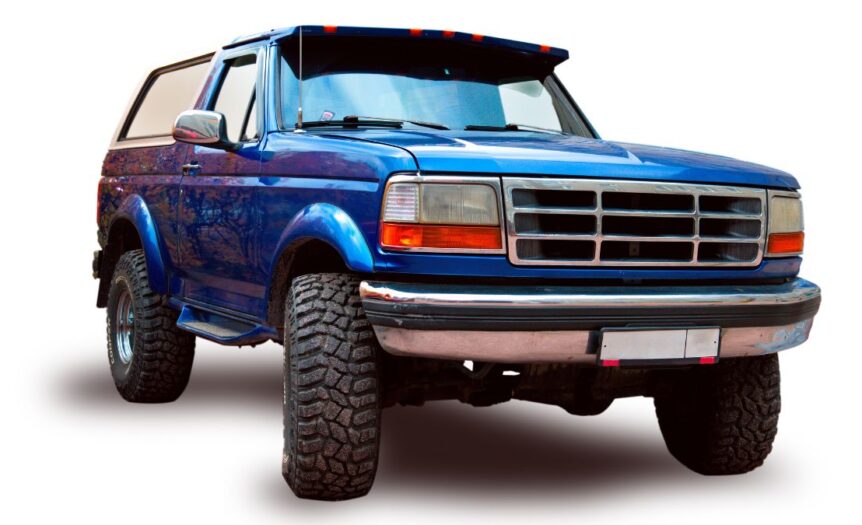Ford’s signature mid-size off-roading SUV is a popular automobile in the industry today. Mainly, this vehicle receives high praise for its advanced driving systems that enhance all-terrain performance, from slippery roads to rocky trails. Read on to learn more about the Ford Bronco’s GOAT mode and how to use it to improve your driving experience.
What Is the GOAT Management System
GOAT, or “goes over any terrain,” was tossed around as a possible name for the Ford Bronco during development in the mid-60s. Today, the GOAT terrain management system is present on newer Broncos (2021+) and features a slew of driving modes designed for nearly any driving conditions. The driver can seamlessly switch between these GOAT modes while driving as conditions change to optimize various performance factors, including traction, power output, fuel economy, torque, and more. Most conveniently, drivers can operate GOAT mode with a user-friendly dial located on near the driver-side seat.
Using the Different GOAT Modes
So, how exactly do you use the different GOAT driving settings? First, it’s essential that you understand the practical applications for each of the following five modes: normal, eco, sport, slippery, and sand. Normal mode is the standard driving setting and is useful for most on-road conditions. In eco mode, your Ford Bronco reduces fuel consumption by limiting the output of non-engine elements—this is ideal for maintaining consistent power usage on long-haul journeys.
Sport mode increases the responsiveness of your Bronco, from acceleration to turning, to add a more thrilling and powerful driving experience. Most drivers use sport mode solely for on-road applications, but the longer transmission-in-gear time is great for maintaining speed through elevations. Slippery mode increases wheel slippage detection to improve traction in snowy, slushy, and wet conditions. Conversely, sand mode disables certain traction controls to enhance loose-surface overlanding. Understanding the different GOAT modes ensures you know the correct driving setting to select in any given environment or situation.
But Wait, There’s More!
Certain Ford Bronco Models, such as the Everglades, Badland, and Black Diamond trims, include up to three additional GOAT modes: Mud/Ruts, rock crawl, and Baja. Meanwhile, the Bronco Raptor boasts an exclusive Tow-Haul driving setting! Overall, these upgraded GOAT modes enhance off-roading and utility capabilities. Mud/Ruts optimizes your Bronco’s performance over muddy and rutted terrains, making it ideal for any uneven surfaces. Rock crawl engages the four-wheel drive locks and rear differential to increase traction on rocky terrains—a front trail camera also activates, helping you avoid environmental obstacles in your path. Baja mode is excellent for desert racing applications and boosts response and torque without sacrificing too much traction. Lastly, the Ford Bronco Tow-Haul mode allows the Raptor model to pull up to 4,500 pounds and maintain superior control while hauling down steep inclines.
Understanding the GOAT mode and how to use it can improve your experience when driving the Ford Bronco. This terrain management system is one of the many factors that make the Bronco ideal for off-roading enthusiasts!










 Deering Estate
Deering Estate
 Massage Envy South Miami
Massage Envy South Miami
 Calla Blow Dry
Calla Blow Dry
 My Derma Clinic
My Derma Clinic
 Sushi Maki
Sushi Maki
 Sports Grill
Sports Grill
 The Healthy Kitchen
The Healthy Kitchen
 Golden Rule Seafood
Golden Rule Seafood
 Malanga Cuban Café
Malanga Cuban Café

 Kathleen Ballard
Kathleen Ballard
 Panter, Panter & Sampedro
Panter, Panter & Sampedro
 Vintage Liquors
Vintage Liquors
 The Dog from Ipanema
The Dog from Ipanema
 Rubinstein Family Chiropractic
Rubinstein Family Chiropractic
 Your Pet’s Best
Your Pet’s Best
 Indigo Republic
Indigo Republic




 ATR Luxury Homes
ATR Luxury Homes


 2112 Design Studio
2112 Design Studio
 Hamilton Fox & Company
Hamilton Fox & Company
 Creative Design Services
Creative Design Services
 Best Pest Professionals
Best Pest Professionals
 HD Tree Services
HD Tree Services
 Trinity Air Conditioning Company
Trinity Air Conditioning Company
 Cisca Construction & Development
Cisca Construction & Development
 Mosquito Joe
Mosquito Joe
 Cutler Bay Solar Solutions
Cutler Bay Solar Solutions


 Miami Royal Ballet & Dance
Miami Royal Ballet & Dance
 Christopher Columbus
Christopher Columbus
 Pineview Preschools
Pineview Preschools
 Westminster
Westminster
 Carrollton
Carrollton
 Lil’ Jungle
Lil’ Jungle
 Frost Science Museum
Frost Science Museum
 Palmer Trinity School
Palmer Trinity School
 South Florida Music
South Florida Music
 Pinecrest Orthodontics
Pinecrest Orthodontics
 Dr. Bob Pediatric Dentist
Dr. Bob Pediatric Dentist
 d.pediatrics
d.pediatrics
 South Miami Women’s Health
South Miami Women’s Health

 The Spot Barbershop
The Spot Barbershop
 My Derma Clinic
My Derma Clinic




 Miami Dance Project
Miami Dance Project

 Rubinstein Family Chiropractic
Rubinstein Family Chiropractic
 Indigo Republic
Indigo Republic

 Safes Universe
Safes Universe
 Vintage Liquors
Vintage Liquors
 Evenings Delight
Evenings Delight





 Atchana’s Homegrown Thai
Atchana’s Homegrown Thai
 Baptist Health South Florida
Baptist Health South Florida

 Laser Eye Center of Miami
Laser Eye Center of Miami
 Visiting Angels
Visiting Angels
 OpusCare of South Florida
OpusCare of South Florida

 Your Pet’s Best
Your Pet’s Best





 HD Tree Services
HD Tree Services
 Hamilton Fox & Company
Hamilton Fox & Company


 Creative Design Services
Creative Design Services